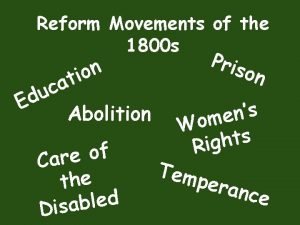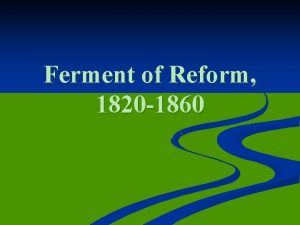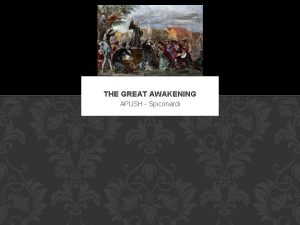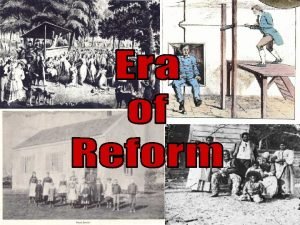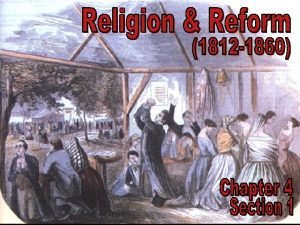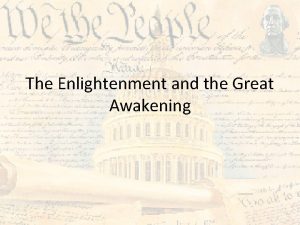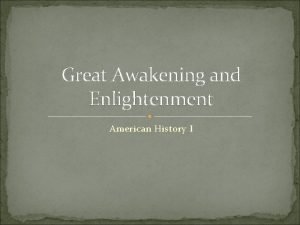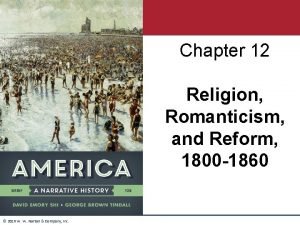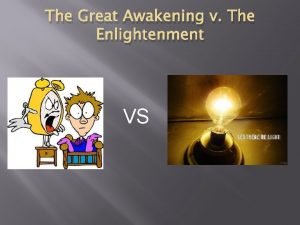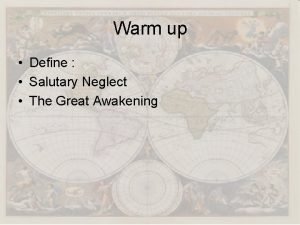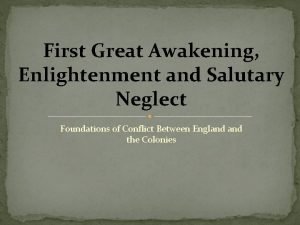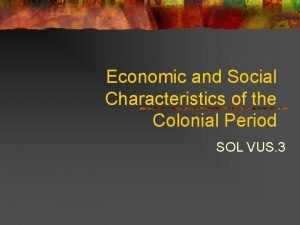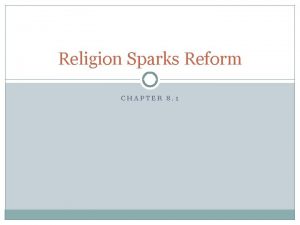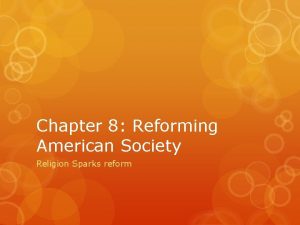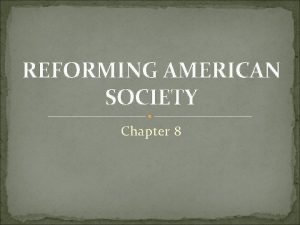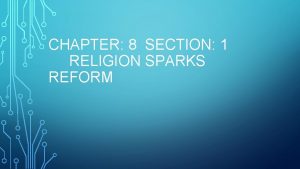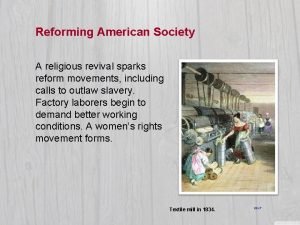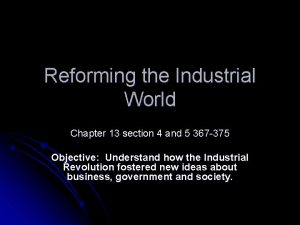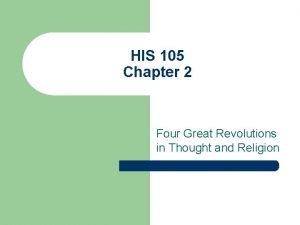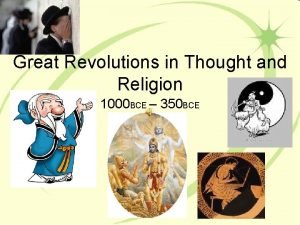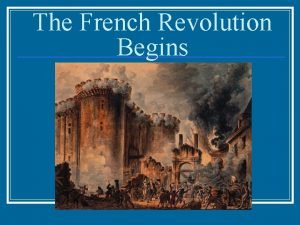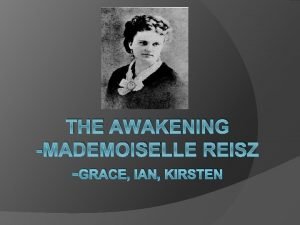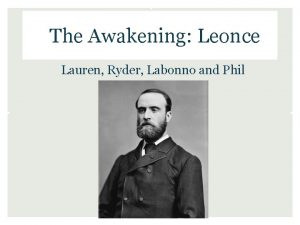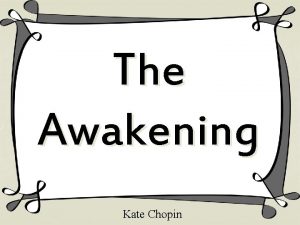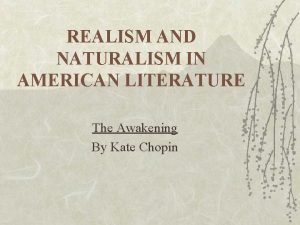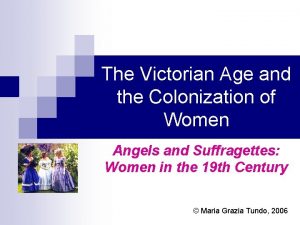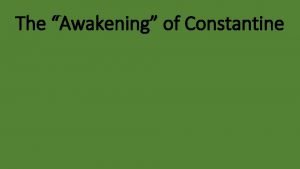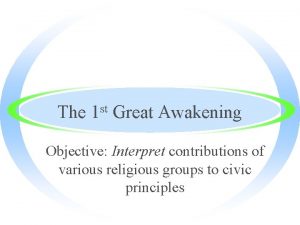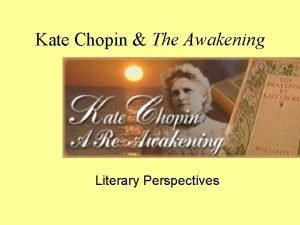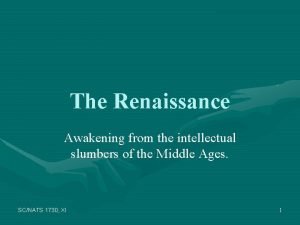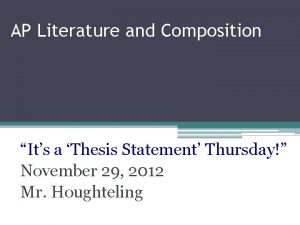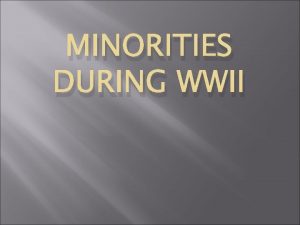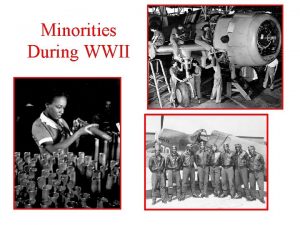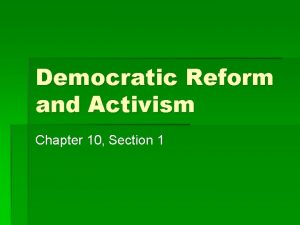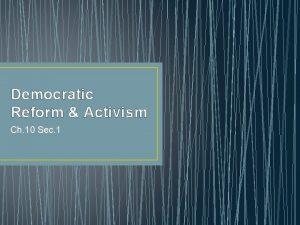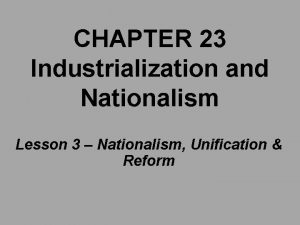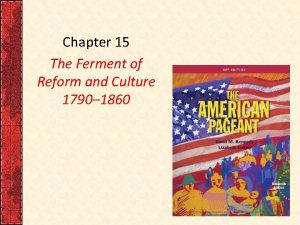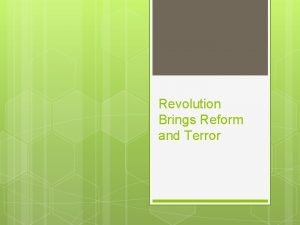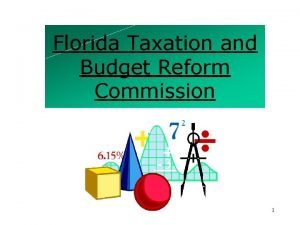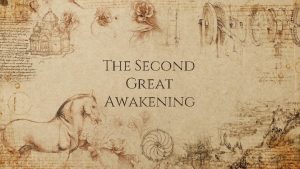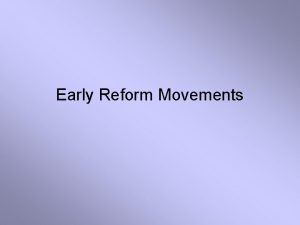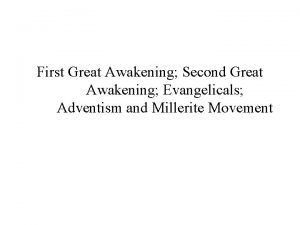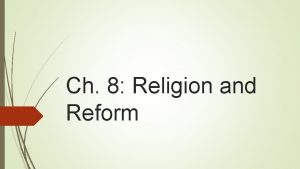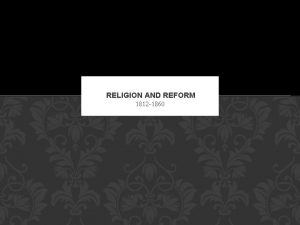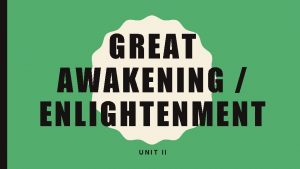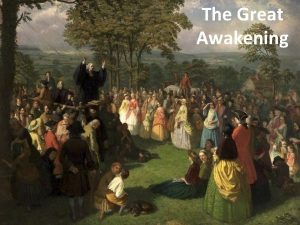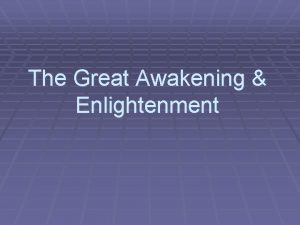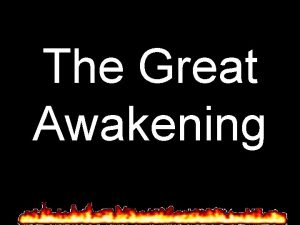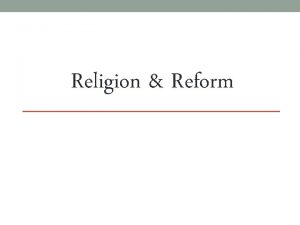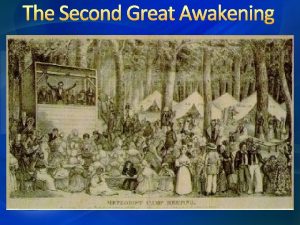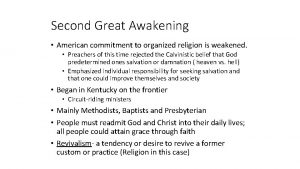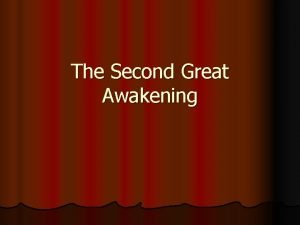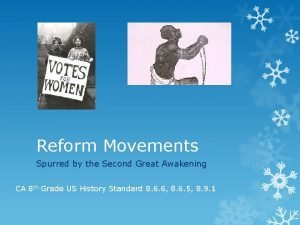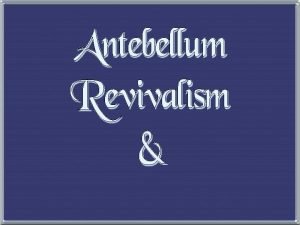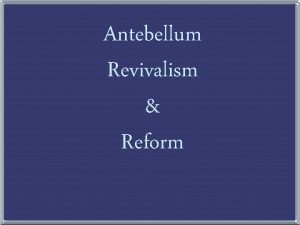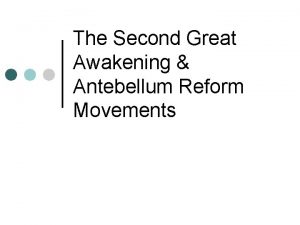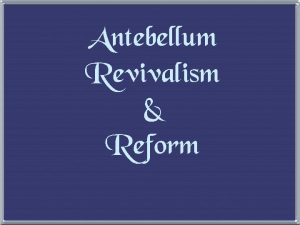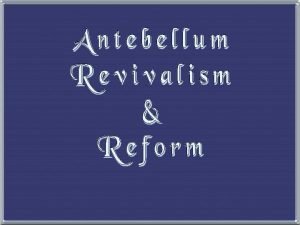Ch 8 Religion and Reform Second Great Awakening
















































- Slides: 48

Ch. 8: Religion and Reform

Second Great Awakening / Revivalists Second Great Awakening – A religious revival that swept the country in the early 1800’s, lasted for almost 50 years, and led to the formation of several new, American-born religions. Revivalists – Protestant preachers who believed that Americans had become immoral and that reviving religious participation was crucial to the country’s future; These preachers started and led the Second Great Awakening. Closure Question #1: Why do you think the religious messages of the Second Great Awakening affected so many Americans?

Second Great Awakening / Revivalists Name two of the three religions discussed in the class which were formed during the Second Great Awakening.

Charles Grandison Finney / Evangelical Charles Grandison Finney – One of the most influential revivalists; Finney is the founder of the Evangelical style of worship. Evangelical – A Christian religious style involving passionate sermons and rousing music designed to stir up strong emotions and attract converts. Closure Question #1: Why do you think the religious messages of the Second Great Awakening affected so many Americans?

Charles Grandison Finney / Evangelical In what region of the country did the Evangelical religion gain the most followers?

Joseph Smith / Mormons Joseph Smith (1805 -1844) – Founder of the Church of Jesus Christ of Latter-Day Saints; claimed to have received revelation from God through heavenly visions and angels authorizing him to re-establish the Church founded by Jesus Christ during his life but that, according to Smith, was lost during the Dark Ages. Mormons – Derogatory name given to Joseph Smith’s followers. The term comes from a new book of scripture translated by Joseph Smith entitled The Book of Mormon which Smith taught was equal in importance to the Bible. Officially, church members prefer to be called Latter-Day Saints.

Joseph Smith / Mormons Where does the nickname “Mormons” come from?

Unitarians Religious movement that emphasizes a belief in the oneness of God, rejecting the concept of the trinity taught in the Catholic and other Christian churches. The First Unitarian Church in the United States was established in Boston in 1782. By 1825 Unitarianism dominated the Northeast United States.

Unitarians In what city was the first Unitarian Church established?

Closure Question #2: What factors led to discrimination against Irish immigrants in the early and middle 1800 s? Members of the Roman Catholic Church faced particularly harsh discrimination in the early 1800 s. Many Protestants viewed Catholicism as incompatible with American ideals of democracy. They believed that Catholics would choose loyalty to the Pope, the leader of the Roman Catholic Church, over loyalty to the United States. “Down with Popery” yelled Protestants in Philadelphia as they rioted against Catholic worshippers, echoing the sentiments of many Americans across the country. Moreover, most Catholics of the time faced discrimination for another reason: their poverty. Many were poor immigrants from Ireland. Because they had little money, they would work for extremely low wages, which threatened other workers. Because Irish immigrants arrived in increasingly large numbers, many feared they were growing too powerful.

Utopian Communities Painting of the Utopian Transcendentalist Community established in Brook Farm, Massachusetts in 1845. Settlements made by dozens of groups who chose to distance themselves from society by setting up communities based on unusual ways of sharing property, labor, and family life.

Utopian Communities What is an example of a Utopian Community that still exists today in the state of Pennsylvania?

Closure Question #3: How did the methods of people who created utopian societies differ from those of other reformers? During the early 1800 s, dozens of groups of Americans sought to improve their lives in a unique way. They chose to distance themselves fro msociety by setting up communities based on unusual ways of sharing property, labor, and family life. Two well-known utopian communities were New Harmony, in Indiana, and Brook Farm, near Boston. In 1825, Robert Owen, a British social reformer, sought to have people from different backgrounds work together in a cooperative society at New Harmony. The society attracted some 1, 000 people whom Owen described as “the industrious and well-disposed of all nations. ” At Brook Farm in 1841, George Ripley and 80 others sought to combine physical and intellectual labor. Brook Farm failed after only six years, while New Harmony lasted just 2 years. Another group that set up a chain of separate communal living societies was the United Society of Believers in Christ’s Second Appearing, more commonly known as the Shakers. The Shakers had organized during the middle 1700 s but reached their peak during the 1840 s. Shakers set up independent villages in New Hampshire, New York, Ohio, and Illinois. Men and women lived in separate housing and did not marry or have children. The communities grew only when adults joined, or when the group took in orphans. The economy flourished because of the Shaker’s careful attention to high-quality crafts and farm produce. Remnants of their settlements still exist today.

Ralph Waldo Emerson 1803 -1882 The founder of Transcendentalism. Emerson taught his followers that through their faith they could transcend, or go beyond, their senses to learn about the world. Emerson is also well known for supporting the abolition of slavery.

Ralph Waldo Emerson was the founder of what religious movement in the United States?

Henry David Thoreau 1817 -1862 American author, Transcendentalist, Abolitionist and follower of Ralph Waldo Emerson; Thoreau was the first American to produce the concept of “Civil Disobedience. ”

Henry David Thoreau’s concept of civil disobedience was used by what African-American leader of the 1960 s?

Closure Assignment #5 Answer the following questions based on what you have learned from Chapter 8, Section 1: 1. Why do you think the religious messages of the Second Great Awakening affected so many Americans? 2. What factors led to discrimination against Irish immigrants in the early and middle 1800 s? 3. How did the methods of people who created utopian societies differ from those of other reformers?

Public School Movement / Horace Mann (1796 -1859) – Leader of the Public School Reform Movement, Massachusetts State Senator, and leader of the first state board of education. Public School Movement – Reform movement with the goal of establishing a public school system supported by tax money and which would require all children to attend. With Mann as its leader, the public school movement succeeded in establishing more effective public school systems in states across the country, making public schools the norm in the 1850’s. Mann argued for state oversight of local schools, standardized school calendars, and adequate school funding. He claimed that expanding education would give Americans the knowledge and intellectual tools they needed to make decisions as citizens of a democracy. Education would promote economic growth by supplying knowledgeable workers and help keep wealthy, educated people from oppressing the uneducated poor. Closure Question #1: According to reformers, how would the public school movement help America’s government and economy?

Public School Movement / Horace Mann The first public schools were built in what region of the United States?

Dorothea Dix / Penitentiary Movement Dorothea Dix (1802 -1887) – American reformer and political activist; Dix campaigned for improvement in the Penitentiary System, Mental Health Care, and Hospitals. Penitentiary Movement – The Prison Reform Movement in the United States; Reformers believed that the purpose of prison should not just be to punish prisoners, but that instead prisons should help criminals feel sorrow for their crimes, repent of them, and then become rehabilitated to re-enter society. Closure Question #2: How effective do you think the penitentiary movement was? Explain.

Dorothea Dix / Penitentiary Movement According to Dorothea Dix and other supporters of the Penitentiary Movement, what should be the purpose of the American prison system?

Temperance Movement / Neal Dow Temperance Movement – The effort to end alcohol abuse and the problems created by it. Neal Dow – Important public speaker of the Temperance Movement. As a mayor in Maine Dow oversaw the establishment of the “Maine Law”, which restricted the sale of alcohol. Within a few years a dozen states had passed similar temperance laws. Closure Question #3: How did leaders of the temperance movement try to solve the problems of crime and poverty?

Temperance Movement / Neal Dow Most of the supporters of the Temperance Movement belonged to which gender?

Closure Assignment #6 Answer the following questions based on what you have learned from Chapter 8, Section 2: 1. According to reformers, how would the public school movement help America’s government and economy? 2. How effective do you think the penitentiary movement was? Explain. 3. How did leaders of the temperance movement try to solve the problems of crime and poverty?

Freedman A Former Slave In the period between 1816 and 1861 the practice of slavery increased steadily in the United States. In 1830 more than 2 million African-Americans were enslaved. The majority of slaves faced cruel treatment. In order to keep slaves in-line overseers used physical punishment (Such as beatings, whipping, and maiming. ) and mental punishment. (Such as public humiliation and the threat of being separated from family members. ) Many slaves did whatever they could to fight against their owners. Resistance included breaking tools, refusing to work, escaping through the Underground Railroad, and taking up weapons in armed rebellions.

Freedman Which freedman became an important public speaker in the Northern United States, arguing against slavery using first-hand experiences?

Closure Question #1: In what ways did enslaved people cope with their captivity? The miserable conditions forced on enslaved people took their inevitable toll. Some, losing all hope, took their own lives. Others simply toiled through a lifetime of pain and sadness. But, in a remarkable triumph of spirit over hardship, most enslaved people maintained their hope and their dignity. They developed many ways of coping with their inhumane conditions. They worked to maintain networks of family and friends. Parents kept family traditions alive by naming children for beloved aunts, uncles, or grandparents, and by passing on family stories that their children could cherish wherever they might find themselves. Enslaved people took comfort in their religion, a unique mix of traditional African and Christian beliefs, which shone the light of hope in the midst of their difficult lives.

Nat Turner Leader of a slave rebellion in 1800 -1831 Virginia in August 1831 in which 60 white people and dozens of blacks were killed. Nat Turner’s rebellion increased fear of slave uprisings among white slave owners throughout the South, leading Southerners to pass more restrictive laws regarding slavery.

Nat Turner What event did Nat Turner interpret as being a sign from God that he should lead a revolt against slave owners in 1831?

Closure Question #2: Why did most free African Americans not support the American Colonization Society? The existence of free African Americans concerned many white Americans, especially slaveholders. They felt that the large population of free African Americans made those still in bondage long all the more for freedom. In 1816, some of the South’s most prominent slaveholders established the American Colonization Society (ACS). The goal of the ACS was to encourage the migration of free blacks to Africa. The ACS established Liberia, a colony on the west coast of Africa, and by 1830 some 1, 110 people from the United States had been relocated there. Most free African American were wary of the motives of the ACS. Most had been born in America, and they considered the United States their home. Moreover, they feared that colonization was just a plan to strengthen slavery by exiling the most able black leaders. Although several thousand free African Americans did eventually migrate to Liberia, most chose to stay in the country of their birth.

Abolition Movement / William Lloyd Garrison Abolition Movement – Reform movement begun in the Northeastern United States which aimed to abolish, or end, the practice of slavery in the United States. William Lloyd Garrison (1805 -1879) – Leading American abolitionist; In 1831 first published The Liberator, an antislavery newspaper which aggressively criticized the practice of slavery by arguing that slavery was morally wrong.

Abolition Movement / William Lloyd Garrison What is the name of the newspaper which was published by Garrison to oppose slavery?

Closure Question #3: What role did religion play in the abolition movement? In cities across the Northeast and the Midwest, abolitionist societies made up of people who shared William Lloyd Garrison’s views sprang up. Founded by Garrison in 1833, the American Anti-Slavery Society had over 150, 000 members nationally by 1840. This group implemented moral suasion by printing antislavery pamphlets and distributing them to churches and other community organizations. The American Anti-Slavery Society and similar groups also supported a team of hundreds of lecturers who spoke against slavery at camp meetings and other public gatherings. They insisted that holding slaves was counter to most Americans’ religious beliefs. Theodore Weld, a student at the Lane Theological Seminary in Ohio, became another leading abolitionist. Weld shared Garrison’s belief in the power of moral suasion. However, whereas Garrison resorted to public confrontation, Weld chose to work through the churches. Weld married Angelina Grimke, the daughter of a southern slaveholder, who was so moved by the abolition movement that she went north to join it. She and her sister Sarah Grimke spoke and wrote against slavery.

Frederick Douglass 1818 -1895 Leading abolitionist and former slave; Douglass impressed and touched Americans with his eloquence and stories about the difficulty of his life as a slave.

Frederick Douglass Though known best as an abolitionist, Douglass was also a supporter of what th other movement in the 19 century?

Gag Rule (1836) Law which prohibited debate and discussion in Congress on the subject of slavery. As abolitionists worked to spread their message, they faced resistance in both the North and Southerners argued that slavery was necessary for their economy to flourish, and that it benefited the Northern factories as well since it was Southern cotton that was manufactured into cloth in the North. Some Southerners also claimed that Christianity supported slavery and that enslaved people could not survive without the loving care of the slaveholders. Northerners tended to agree with the South’s economic defense of slavery. Working-class immigrants to the United States who competed with free African-Americans for jobs, such Irish and Italians, also supported slavery and racism. Though most Northerners did not like Southerners, they wanted to avoid controversy by debating the issue of slavery. This factor led to the acceptance of the Gag Rule.

Gag Rule What topic was forbidden to be discussed in Congress in 1836?

Closure Assignment #7 Answer the following questions based on what you have learned from Chapter 8, Section 3: 1. In what ways did enslaved people cope with their captivity? 2. Why did most free African Americans not support the American Colonization Society? 3. What role did religion play in the abolition movement?

Women’s Movement / Sojourner Truth (1797 -1883) – Effective abolitionist lecturer and former slave; like Frederick Douglass, Sojourner Truth amazed Americans with her powerful arguments and heartfelt accounts of slavery. Women’s Movement – A movement working for greater rights and opportunities for women from the 1830’s to the 1910’s. Closure Question #1: Why do you think women’s rights were so limited in the early years of the country?

Women’s Movement / Sojourner Truth In what ways were the Women’s Movement and the Abolition Movement similar? Give at least 1 specific similarity.

Lucretia Mott / Elizabeth Cady Stanton Lucretia Mott (1793 -1880) and Elizabeth Cady Stanton (18151902) – Active reformers who supported Abolition, Temperance, and the Women’s Movement; together the two organized the Seneca Falls Convention in 1848. Closure Question #2: Why did some abolitionists become outspoken advocates of women’s rights?

Lucretia Mott / Elizabeth Cady Stanton Mott and Stanton were the key organizers of what important event in the Women’s Movement which took place in 1848?

Seneca Falls Convention / Suffrage Seneca Falls Convention (1848) – America’s first Women’s Rights Convention; participants in the meeting created the Declaration of Sentiments which stated that women should have the same right as men. Suffrage – The right for women to vote in the United States; Suffrage was the key goal of the Women’s Rights Movement of the 1800’s and early 1900’s. Closure Question #3: How significant do you think the Seneca Falls Convention was? Explain your answer.

Seneca Falls Convention / Suffrage The Declaration of Sentiments, created and signed by the women who attended the Seneca Falls Convention, was modeled after what important document of the American Revolution?

Married Women’s Property Act Law passed by the State of New York in 1848 which guaranteed many property rights to women.

Married Women’s Property Act The Married Women’s Property Act first became law in which state?

Closure Assignment #8 Answer the following questions based on what you have learned from Chapter 8, Section 4: 1. Why do you think women’s rights were so limited in the early years of the country? 2. Why did some abolitionists become outspoken advocates of women’s rights? 3. How significant do you think the Seneca Falls Convention was? Explain your answer.
 Second great awakening
Second great awakening American reform movements between 1820 and 1860
American reform movements between 1820 and 1860 Second great awakening apush chapter 15
Second great awakening apush chapter 15 Second great awakening apush
Second great awakening apush Awakening objectives poe
Awakening objectives poe Enlightenment
Enlightenment Second great awakening
Second great awakening Define second great awakening
Define second great awakening The enlightenment and the great awakening
The enlightenment and the great awakening Great awakening and enlightenment
Great awakening and enlightenment Chapter 12: religion, romanticism, and reform, 1800–1860
Chapter 12: religion, romanticism, and reform, 1800–1860 Great awakening vs the enlightenment
Great awakening vs the enlightenment Salutary neglect define
Salutary neglect define Enlightenment vs great awakening
Enlightenment vs great awakening The great awakening laid the social foundations for the
The great awakening laid the social foundations for the Chapter 8 section 1 religion sparks reform
Chapter 8 section 1 religion sparks reform Chapter 8 section 1 religion sparks reform
Chapter 8 section 1 religion sparks reform Chapter 8 section 1 religion sparks reform
Chapter 8 section 1 religion sparks reform Religion sparks reform
Religion sparks reform Religion sparks reform
Religion sparks reform Reforming the industrial world chapter 9 section 4
Reforming the industrial world chapter 9 section 4 Western religion vs eastern religion
Western religion vs eastern religion Four great revolutions in thought and religion
Four great revolutions in thought and religion Pythagorean theorem
Pythagorean theorem 186 282 miles per second into meters per second
186 282 miles per second into meters per second What does monotheistic mean? *
What does monotheistic mean? * Adele ratignolle quotes
Adele ratignolle quotes Storming of the bastille political cartoon
Storming of the bastille political cartoon Mademoiselle reisz the awakening
Mademoiselle reisz the awakening Doc phill the awakening
Doc phill the awakening The awakening kate chopin synopsis
The awakening kate chopin synopsis Is the awakening realism or naturalism
Is the awakening realism or naturalism The awakening conscience
The awakening conscience Constantine
Constantine Awakening objective
Awakening objective Literary devices in the awakening
Literary devices in the awakening The key to oneida's financial success was
The key to oneida's financial success was Renaissance awakening
Renaissance awakening Naturalism in the awakening
Naturalism in the awakening The awakening thesis statements
The awakening thesis statements Short summary of the great gatsby
Short summary of the great gatsby Second great migration
Second great migration Second great migration
Second great migration Democratic reform and activism
Democratic reform and activism Chapter 10 section 1 democratic reform and activism
Chapter 10 section 1 democratic reform and activism Chapter 23 lesson 3 nationalism unification and reform
Chapter 23 lesson 3 nationalism unification and reform The ferment of reform and culture
The ferment of reform and culture Revolution brings reform and terror
Revolution brings reform and terror Taxation and budget reform commission
Taxation and budget reform commission
